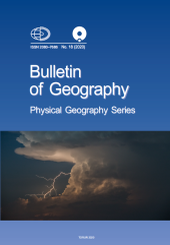The origin and course of severe thunderstorm outbreaks in Poland on 10 and 11 August, 2017
DOI:
https://doi.org/10.2478/bgeo-2020-0003Keywords
thunderstorm, lightning, cloud-to-ground flashes, mesoscale convective system, natural disasters, PolandAbstract
This study documents the evolution of severe thunderstorm outbreaks that occurred on 10 and 11 August, 2017 in Poland. This study used cloud-to-ground lightning-strike data from the PERUN lightning detection network managed by the Polish Institute of Meteorology and Water Management – National Research Institute. In the description of storm phenomena the authors also applied synoptic maps, meteorological radar data, vertical atmosphere soundings and meteorological data from the station in Poland. The aim of this study was to trace the causes of the upward movement of supercells including the Mesoscale Convective System day by day, and to examine relationships between lighting distributions on 10 and 11 August, 2017. In Poland, on August 10, 2017, 154,524 cloud-to-ground flashes (CG) occurred, and 56,510 CG flashes the next day. On August 10, around 18% of all flashes had a positive current, but 29% the next day. The spatial distribution of the lightning in Poland was computed for 10×10-km grid cells. Based on the map analysis it was found that on those two days most of the positive flashes occurred in Greater Poland and Kuyavian-Pomeranian voivodships, as well as on the border of Opolskie and Lower Silesia.References
ALLEN JT, 2018, Climate change and severe thunderstorms. In: Von Storch H, et al. (eds) Oxford Research Encyclopedia of Climate Science. Oxford University Press, 1–37, https://doi.org/10.1093/acrefore/9780190228620.013.62.
ATKINS NT and ST. LAURENT M, 2009, Bow echo mesovortices. Part I: Processes that influence their damaging potential. Monthly Weather Review 137: 1497–1513, doi.org/10.1175/2008MWR2649.1.
BARCZYK M, 2013, Wykorzystanie radaru meteorologicznego do detekcji i prognozy zjawisk meteorologicznych. Instytut Meteorologii i Gospodarki Wodnej, Warszawa: 4–24.
BIELEC Z, 1998, Long-term variability of the thunderstorm frequency in Szczecin, Łódź, Kraków and Kasprowy Wierch in the period 1954–1993. Acta Universitatis Lodziensis, Folia Geographica Physica 3: 449–453.
BIELEC-BĄKOWSKA Z, 2007, Wyznaczanie regionów burzowych w Polsce. Annales Universitatis Mariae Curie-Skłodowska B 61 (6): 57–64.
BIELEC-BĄKOWSKA Z, 2013, Burze i grady w Polsce. Prace Geograficzne Instytutu Geografii i Gospodarki Przestrzennej, Uniwersytet Jagielloński 132: 99–132.
BODZAK P, 2006, Detekcja i lokalizacja wyładowań atmosferycznych. Seria: Instrukcje
i podręczniki, Wydawnictwo IMGW, Warszawa.
BROOKS HE, 2013, Severe thunderstorms and climate change. Atmospheric Research 123: 129–138, https://doi.org/10.1016/j.atmosres.2012.04.002.
CELIŃSKI-MYSŁAW D and ŁOBODA Ł, 2019, Kinematic and thermodynamic conditions related to convective systems with a bow echo in Poland. Theoretical and Applied Climatology 137: 2109–2123.
CZERNECKI B, TASZAREK M, KOLENDOWICZ L and KONARSKI J, 2016, Relationship between human observations of thunderstorms and PERUN lightning detection network in Poland. Atmospheric Research, 167: 118–128.
DAHL JML and PARKER MD, 2012, Uncertainties in trajectory calculations within near-surface mesocyclones of simulated supercells, Monthly Weather Review 140 (9): 2959–2966.
DOTZEK N, GROENEMEIJER P, FEUERSTEIN B and HOLZER AM, 2009, Overview of ESSL’s severe convective storms research using the European Severe Weather Database ESWD. Atmospheric Research 93: 575−586.
General Directorate of the State Forests, 2019, https://www.lasy.gov.pl/pl (access: 28.10.19).
HOLLE RL, CUMMINS K and BROOKS WA, 2016, Seasonal, monthly, and weekly distribution of NLDN and GLD360 cloud-to-ground lightning. Monthly Weather Review 144(8), DOI: 10.1175/MWR-D-16-0051.1
Main Building Control Inspectorate, 2019, https://www.gunb.gov.pl/. (access: 28.10.19).
MÄKELÄ A and ROSSI P, 2011, The daily cloud-to-ground lightning flash density in the contiguous United States and Finland. Monthly Weather Review 139 (5), 1323–1337.
NAG A and RAKOV VA, 2012, Positive lighting: An overview, new observation and inferences. Journal of Geophysical Research, 117, doi:10.1029/2012JD017545.
PÚČIK T, GROENEMEIJERA P, RÄDLERA AT, TIJSSENA L, NIKULIND G, PREINE AF, VAN MEIJGAARDG E, FEALYH R, JACOBI D and TEICHMANNI C, 2017, Future changes in European severe convection environments in a regional climate model ensemble. Journal of Climate 30, 6771–6794, https://doi.org/10.1175/JCLI-D-16-0777.1.
TASZAREK M, CZERNECKI B, 2015, A cloud-to-ground lightning climatology for Poland. Monthly Weather Review 143, 4285–4304, DOI: 10.1175/MWR-D-15-0206.1.
TASZAREK M, BROOKS HE and CZERNECKI B, 2017, Sounding-derived parameters associated with convective hazards in Europe. Monthly Weather Review 145, 1511–1528.
TASZAREK M, PILGUJ N, ORLIKOWSKI J, SUROWIECKI A, WALCZAKIEWICZ S, PILORZ W, PIASECKI K, PAJUREK Ł and PÓŁROLNICZAK M, 2019, Derecho evolving from a mesocyclone – A study of 11 August 2017 severe weather outbreak in Poland: Event analysis and high-resolution simulation. Monthly Weather Review 145, 1511–1528.
TASZAREK M, SZUSTER P and FORTUNIAK K, 2018, Climatological aspects of convective parameters over Europe: A comparison of ERA-Interim and sounding data. Journal of Climate 31, 4281–4308, https://doi.org/10.1175/JCLI-D-17-0596.1.
TRAPP RJ and WEISMAN ML, 2003, Low-level mesovortices within squall lines and bow echoes. Part II: Their genesis and implications. Monthly Weather Review 131, 2804–2823, https://doi.org/10.1175/1520-0493(2003)131,2804:LMWSLA.2.0.CO;2.
Univeristy of Wyoming, 2019, http://weather.uwyo.edu/upperair/sounding.html (access: 20.11.2019).
Downloads
Published
How to Cite
Issue
Section
License
Copyright (c) 2020 Bulletin of Geography. Physical Geography Series

This work is licensed under a Creative Commons Attribution-NoDerivatives 4.0 International License.
Stats
Number of views and downloads: 537
Number of citations: 8



